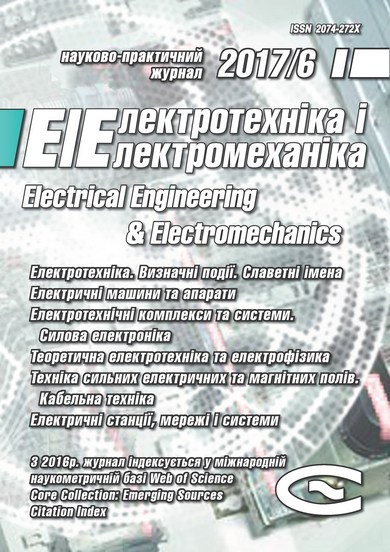NUMERICAL SIMULATION OF THERMAL BEHAVIOR AND OPTIMIZATION OF a-Si/a-Si/C-Si/a-Si/A-Si HIT SOLAR CELL AT HIGH TEMPERATURES
DOI:
https://doi.org/10.20998/2074-272X.2017.6.07Keywords:
heterojunction with intrinsic thin layer cell, high temperature, thermal behaviorAbstract
Purpose. Silicon heterostructure solar cells, particularly Heterojunction with Intrinsic Thin layer (HIT) cells, are of recommended silicon cells in recent years that are simply fabricated at low processing temperature and have high optical and temperature stability and better efficiency than homojunction solar cells. In this paper, at first a relatively accurate computational model is suggested for more precise calculation of the thermal behavior of such cells. In this model, the thermal dependency of many parameters such as mobility, thermal velocity of carriers, band gap, Urbach energy of band tails, electron affinity, relative permittivity, and effective density of states in the valence and conduction bands are considered for all semiconductor layers. The thermal behavior of HIT solar cells in the range of 25-75 °C is studied by using of this model. The effect of the thickness of different layers of HIT cell on its external parameters has been investigated in this temperature range, and finally the optimal thicknesses of HIT solar cell layers to use in wide temperature range are proposed.References
1. Datta A., Chatterjee P. Computer Modeling of Heterojunction with Intrinsic Thin Layer «HIT» Solar Cells: Sensitivity Issues and Insights Gained, in Solar Cells-Thin-Film Technologies. InTech Publ., 2011.
2. Pascual Sánchez D. Crystalline silicon Heterojunction solar cells. Universitat Politècnica de Catalunya, 2015.
3. Jäger K. et al. Solar energy fundamentals, technology and systems. Delft University of technology, 2014. 78 p.
4. Masuko K., Shigematsu M., Hashiguchi T., Fujishima D., Kai M., Yoshimura N., Yamaguchi T., Ichihashi Y., Mishima T., Matsubara N., Yamanishi T., Takahama T., Taguchi M., Maruyama E., Okamoto S. Achievement of More Than 25% Conversion Efficiency With Crystalline Silicon Heterojunction Solar Cell. IEEE Journal of Photovoltaics, 2014, vol.4, no.6, pp. 1433-1435. doi: 10.1109/JPHOTOV.2014.2352151.
5. Zhang D., Tavakoliyaraki A., Wu Y., R.A.C.M.M. van Swaaij, Zeman M. Influence of ITO deposition and post annealing on HIT solar cell structures. Energy Procedia, 2011, vol.8, p. 207-213. doi: 10.1016/j.egypro.2011.06.125.
6. Lee S., Tark S.J., Kim C.S., Jeong D.Y., Lee J.C., Kim W.M., Kim D. Influence of front contact work function on silicon heterojunction solar cell performance. Current Applied Physics, 2013, vol.13, no.5, pp. 836-840. doi: 10.1016/j.cap.2012.12.013.
7. Li G., Zhou Y., Liu F. Influence of textured c-Si surface morphology on the interfacial properties of heterojunction silicon solar cells. Journal of Non-Crystalline Solids, 2012, vol.358, no.17, pp. 2223-2226. doi: 10.1016/j.jnoncrysol.2011.12.106.
8. Shen L., Meng F., Liu Z. Roles of the Fermi level of doped a-Si: H and band offsets at a-Si: H/c-Si interfaces in n-type HIT solar cells. Solar Energy, 2013, vol.97, p. 168-175. doi: 10.1016/j.solener.2013.08.028.
9. Hayashi Y., Li D., Ogura A., Ohshita Y. Role of i-aSi:H layers in aSi:H/cSi heterojunction solar cells. IEEE Journal of Photovoltaics, 2013, vol.3, no.4, pp. 1149-1155. doi: 10.1109/JPHOTOV.2013.2274616.
10. Dwivedi N., Kumar S., Bisht A., Patel K., Sudhakar S. Simulation approach for optimization of device structure and thickness of HIT solar cells to achieve ~27 % efficiency. Solar energy, 2013. vol.88: pp. 31-41. doi: 10.1016/j.solener.2012.11.008.
11. Jian L., Shihua H., Lü H. Simulation of a high-efficiency silicon-based heterojunction solar cell. Journal of Semiconductors, 2015, vol.36, no.4, p. 044010. doi: 10.1088/1674-4926/36/4/044010.
12. Wanlass M.W., Coutts T.J., Ward J.S., Emery K.A., Gessert T.A., Osterwald C.R. Advanced high-efficiency concentrator tandem solar cells. The Conference Record of the Twenty-Second IEEE Photovoltaic Specialists Conference, 1991. doi: 10.1109/PVSC.1991.169179.
13. Taguchi M., Maruyama E., Tanaka M. Temperature dependence of amorphous/crystalline silicon heterojunction solar cells. Japanese Journal of Applied Physics, 2008, vol.47, no.2, pp. 814-818. doi: 10.1143/JJAP.47.814.
14. Vishkasougheh M.H., Tunaboylu B. Simulation of high efficiency silicon solar cells with a hetero-junction microcrystalline intrinsic thin layer. Energy conversion and management, 2013, vol.72, pp. 141-146. doi: 10.1016/j.enconman.2012.10.025.
15. Agarwal M., Dusane R.O. Temperature dependent analysis of heterojunction silicon solar cells: Role of intrinsic layer thickness. 2015 IEEE 42nd Photovoltaic Specialist Conference (PVSC), Jun. 2015. doi: 10.1109/PVSC.2015.7356058.
16. Sachenko A.V., Kryuchenko Y.V., Kostylyov V.P., Bobyl A.V., Terukov E.I., Abolmasov S.N., Abramov A.S., Andronikov D.A., Shvarts M.Z., Sokolovskyi I.O., Evstigneev M. Temperature dependence of photoconversion efficiency in silicon heterojunction solar cells: Theory vs experiment. Journal of Applied Physics, 2016, vol.119, no.22, p. 225702. doi: 10.1063/1.4953384.
17. Varache R., Leendertz C., Gueunier-Farret M.E., Haschke J., Muñoz D., Korte L. Investigation of selective junctions using a newly developed tunnel current model for solar cell applications. Solar Energy Materials and Solar Cells, 2015, vol.141, pp. 14-23. doi: 10.1016/j.solmat.2015.05.014.
18. Altermatt P.P. Models for numerical device simulations of crystalline silicon solar cells - a review. Journal of Computational Electronics, 2011, vol.10, no.3, pp. 314-330. doi: 10.1007/s10825-011-0367-6.
19. Powell M.J., Deane S.C. Improved defect-pool model for charged defects in amorphous silicon. Physical Review B, 1993, vol.48, no.15, pp. 10815-10827. doi: 10.1103/physrevb.48.10815.
20. Ganji J., Kosarian A., Kaabi H. Numerical modeling of thermal behavior and structural optimization of a-Si:H solar cells at high temperatures. Journal of Computational Electronics, 2016, vol.15, no.4, pp. 1541-1553. doi: 10.1007/s10825-016-0913-3.
Downloads
Published
How to Cite
Issue
Section
License
Copyright (c) 2017 Jabbar Ganji

This work is licensed under a Creative Commons Attribution-NonCommercial 4.0 International License.
Authors who publish with this journal agree to the following terms:
1. Authors retain copyright and grant the journal right of first publication with the work simultaneously licensed under a Creative Commons Attribution License that allows others to share the work with an acknowledgement of the work's authorship and initial publication in this journal.
2. Authors are able to enter into separate, additional contractual arrangements for the non-exclusive distribution of the journal's published version of the work (e.g., post it to an institutional repository or publish it in a book), with an acknowledgement of its initial publication in this journal.
3. Authors are permitted and encouraged to post their work online (e.g., in institutional repositories or on their website) prior to and during the submission process, as it can lead to productive exchanges, as well as earlier and greater citation of published work.





